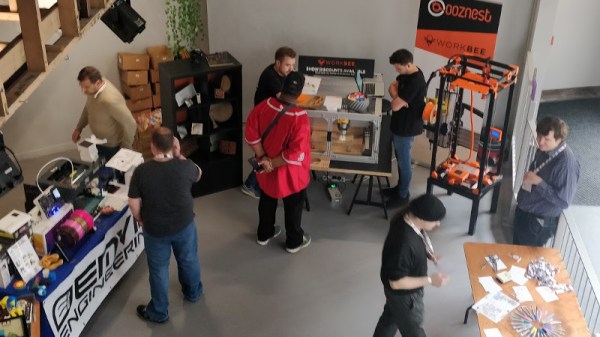Most people buy expensive cameras and use them rather than taking them apart, but Linus Tech Tips has a different approach. They decided that they would rather take the camera apart, with a view to converting it to water cooling. Why? Well, that’s perhaps like asking why climb Mount Everest: because it is there. The practicality (or desirability) of water-cooling an 8K camera aside, the teardown is rather interesting from an an engineering point of view. The RED HELIUM 8K costs about $25K, and most of us don’t often get a look inside equipment like this.
Day: June 14, 2019
Gigapixel Microscope Reveals Tiny Parts Of The Big Picture
[JBumstead] didn’t want an ordinary microscope. He wanted one that would show the big picture, and not just in a euphemistic sense, either. The problem though is one of resolution. The higher the resolution in an image — typically — the narrower the field of view given the same optics, which makes sense, right? The more you zoom in, the less area you can see. His solution was to create a microscope using a conventional camera and building a motion stage that would capture multiple high-resolution photographs. Then the multiple photos are stitched together into a single image. This allows his microscope to take a picture of a 90x60mm area with a resolution of about 15 μm. In theory, the resolution might be as good as 2 μm, but it is hard to measure the resolution accurately at that scale.
As an Arduino project, this isn’t that difficult. It’s akin to a plotter or an XY table for a 3D printer — just some stepper motors and linear motion hardware. However, the base needs to be very stable. We learned a lot about the optics side, though.
Continue reading “Gigapixel Microscope Reveals Tiny Parts Of The Big Picture”
Bringing Pneumatics To The Masses With Open Source Soft Robotics
Soft robotics is an exciting field. Mastering the pneumatic control of pliable materials has enormous potential, from the handling of delicate objects to creating movement with no moving parts. However, pneumatics has long been overlooked by the hacker community as a mode of actuation. There are thousands of tutorials, tools and products that help us work with motor control and gears, but precious few for those of us who want to experiment with movement using air pressure, valves and pistons.
Physicist and engineer [tinkrmind] wants to change that. He has been developing an open source soft robotics tool called Programmable Air for the past year with the aim of creating an accessible way for the hacker community to work with pneumatic robotics. We first came across [tinkrmind]’s soft robotics modules at World Maker Faire in New York City in 2018 but fifty beta testers and a wide range of interesting projects later — from a beating silicone heart to an inflatable bra — they are now being made available on Crowd Supply.
We had the chance to play with some of the Programmable Air modules after this year’s Makerfaire Bay Area at Bring A Hack. We can’t wait to see what squishy, organic creations they will be used for now that they’re out in the wild.
If you need more soft robotics inspiration, take a look at this robotic skin that turns teddy bears into robots from Yale or these soft rotating actuators from Harvard.
See a video of the Programmable Air modules in action below the cut. Continue reading “Bringing Pneumatics To The Masses With Open Source Soft Robotics”
Stylish Alarm Clock Rocks A VFD
There are a great many display technologies available if you wish to make a digital clock. Many hackers seem to have a penchant for the glowier fare from the Eastern side of the Berlin Wall. [ChristineNZ] is one such hacker, and managed to secure some proper Soviet kit for an alarm clock build.
The clock employs an IV-27M vacuum fluorescent display, manufactured in the now-defunct USSR. Featuring 13 seven-segment digits, it’s got that charming blue glow that you just don’t get with other technologies. A MAX6921AWI chip is used to drive the VFD, and an Arduino Mega is the brains of the operation. There’s also an HD44780-compliant LCD that can display further alphanumeric information, and a 4×4 keypad for controlling the device.
The best part of the build though is the enclosure. The VFD is encased in a glass tube, and supported at either end by 90-degree copper pipe couplers. These hold the VFD aloft, and also act as a conduit for the wires coming off each end of the tube. It’s all built on top of a wooden base that holds the rest of the electronics.
It’s an attractive build, and we love the floating look created by the glass tube construction. It’s not the first time we’ve seen old Russian VFDs, and we doubt it will be the last. Video after the break.
Meet The Bootstrap Winners Of The 2019 Hackaday Prize
The twenty projects that won this year’s Hackaday Prize bootstrap competition have just been certified. The purpose of this is to help great examples of early entries offset the cost that goes into prototyping as they work on their projects throughout the summer.
We know this has had a big impact on entries in the past. When working on hard projects it’s easy to doubt yourself, but you can usually get over that with just a bit of outside validation. Alex Williams encountered this when he first entered his Open Source Under Water Glider into the 2017 Hackaday Prize. He wanted to show off his work but didn’t think there’d be much interest and wasn’t sure if he’d continue development. He was shocked by the number of people who were excited about it, continued working feverishly on it, and went on to win the grand prize.
You’ll find all 20 bootstrap winners listed below, but we wanted to feature a couple of examples to show the kind of work that is happening during the Hackady Prize. The results of the bootstrap competition have no bearing on the top prizes: they are all still up for grabs, so enter your project today!
Continue reading “Meet The Bootstrap Winners Of The 2019 Hackaday Prize”
This British 3D Printing Meetup Is On The Rise
Most people who are serious about designing, building, or improving 3D printers see the Midwest Reprap Festival as the place where the latest and greatest is on show for all to see. But if you live on the other side of the world as I do, chances are slim that you’ll be able to attend.
I live in the UK, and there haven’t traditionally been any events quite like MRRF, but that may be changing. The 3D Meetup UK in Birmingham is a community-organised event bringing together the 3D printing maker and hacker community for a couple of days of talks, demonstrations, and tours. I went along this year to see what was going on, and to take the temperature of the British side of this community.
Continue reading “This British 3D Printing Meetup Is On The Rise”
Hackaday Podcast 023: Everything Breaks… Raspberry Pi, ADS-B, Hackaday Website, And Automotive Airbags
Mike Szczys and Elliot Williams talk news and great hacks from the past seven days. Sad word this week as Maker Media, the company behind Make Magazine and Maker Faire, have closed their doors. There seems to be a lot of news about broken hardware and software to discuss, with ADS-B problems grounding hundreds of flights in the US, Hackaday itself having a site outage, the Raspberry Pi 3 B+ can be bricked with a really easy mistake, and Lewin wrote a great overview of the Takata airbag debacle. Don’t worry there are still plenty of hacks as we look at old computers that sing, microcontrollers that chiptune, beat boxes that are actually boxes, and some very neat cartridge hacks for NES and Arduboy.
Take a look at the links below if you want to follow along, and as always tell us what you think about this episode in the comments!
Take a look at the links below if you want to follow along, and as always, tell us what you think about this episode in the comments!
Direct download (60 MB or so.)


















